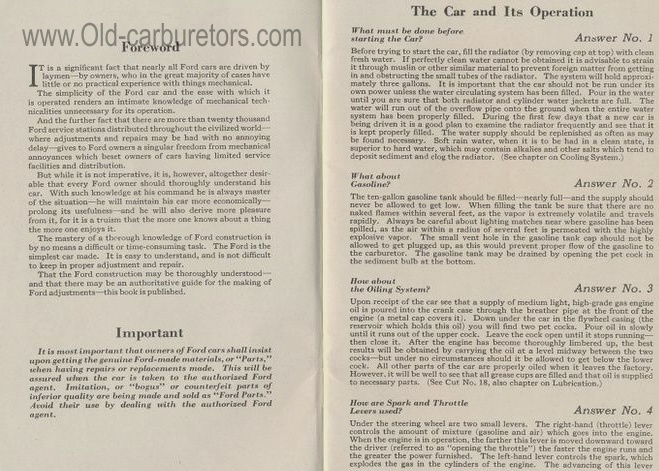First |
Previous Page |
Next Page |
Last | Model T Home
Foreword
IT is a significant fact that nearly all Ford cars are driven by laymen —
by owners, who in the great majority of cases have little or no practical experience
with things mechanical. The simplicity of the Ford car and the ease with which
it is operated renders an intimate knowledge of mechanical technicalities unnecessary
for its operation.
And the further fact that there are more than twenty thousand Ford service
stations distributed throughout the civilized world —where adjustments and
repairs may be had with no annoying delay gives to Ford owners a singular freedom
from mechanical annoyances which beset owners of cars having limited service
facilities and distribution.
But while it is not imperative, it is, however, altogether desirable that every
Ford owner should thoroughly understand his car. With such knowledge at his
command he is always master of the situation—he will maintain his car more
economically—prolong its usefulness and he will also derive more pleasure from
it, for it is a truism that the more one knows about a thing the more one enjoys
it.
The mastery of a thorough knowledge of Ford construction is by no means a difficult
or time-consuming task. The Ford is the simplest car made. It is easy to understand,
and is not difficult to keep in proper adjustment and repair.
That the Ford construction may be thoroughly understood—and that there may
be an authoritative guide for the making of Ford adjustments this book is published.
Important
It is most important that owners of Ford cars shall insist upon getting the
genuine Ford-made materials, or "Parts," when having repairs or replacements
made. This will be assured when the car is taken to the authorized Ford agent.
Imitation, or "bogus" or counterfeit parts of inferior quality are
being made and sold as "Ford Parts." Avoid their use by dealing with
the authorized Ford agent.
The Car and Its Operation
What must be done before
starting the Car? Answer No. 1
Before trying to start the car, fill the radiator (by removing cap at top)
with clean fresh water. If perfectly clean water cannot be obtained it is advisable
to strain it through muslin or other similar material to prevent foreign matter
from getting in and obstructing the small tubes of the radiator. The system
will hold approximately three gallons. It is important that the car should
not be run under its own power unless the water circulating system has been
filled. Pour in the water until you are sure that both radiator and cylinder
water jackets are full. The water will run out of the overflow pipe onto the
ground when the entire water system has been properly filled. During the first
few days that a new car is being driven it is a good plan to examine the radiator
frequently and see that it is kept properly filled. The water supply should
be replenished as often as may be found necessary. Soft rain water, when it
is to be had in a clean state, is superior to hard water, which may contain
alkalies and other salts which tend to deposit sediment and clog the radiator.
(See chapter on Cooling System.)
What about
Gasoline? Answer No. 2
The ten-gallon gasoline tank should be filled nearly full and the supply should
never be allowed to get low. When filling the tank be sure that there are no
naked flames within several feet, as the vapor is extremely volatile and travels
rapidly. Always be careful about lighting matches near where gasoline has been
spilled, as the air within a radius of several feet is permeated with the highly
explosive vapor. The small vent hole in the gasoline tank cap should not be
allowed to get plugged up, as this would prevent proper flow of the gasoline
to the carburetor. The gasoline tank may be drained by opening the pet cock
in the sediment bulb at the bottom.
How about
the Oiling System? Answer No. 3
Upon receipt of the car see that a supply of medium light, high-grade gas engine
oil is poured into the crank case through the breather pipe at the front of
the engine (a metal cap covers it). Down under the car in the flywheel casing
(the reservoir which holds this oil) you will find two pet cocks. Pour oil
in slowly until it runs out of the upper cock. Leave the cock open until it
stops running —then close it. After the engine has become thoroughly limbered
up, the best results will be obtained by carrying the oil at a level midway
between the two cocks —but under no circumstances should it be allowed to get
below the lower cock. All other parts of the car are properly oiled when it
leaves the factory. However, it will be well to see that all grease cups are
filled and that oil is supplied to necessary parts. (See Cut No. 18, also chapter
on Lubrication.)
How are Spark and Throttle
Levers used? Answer No. 4
Under the steering wheel are two small levers. The right-hand (throttle) lever
controls the amount of mixture (gasoline and air) which goes into the engine.
When the engine is in operation, the farther this lever is moved downward toward
the driver (referred to as "opening the throttle") the faster the
engine runs and the greater the power furnished. The left-hand lever controls
the spark, which explodes the gas in the cylinders of the engine. The advancing
of this lever
[3)
